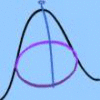Skip over navigation


Or search by topic
Number and algebra
Geometry and measure
Probability and statistics
Working mathematically
Advanced mathematics
For younger learners
Contrary Logic
Age 16 to 18
Challenge Level 





- Problem
- Getting Started
- Student Solutions
- Teachers' Resources
With this question, you need to work through each piece slowly and
carefully. Take your time to understand the symbols and say the
equations out loud.
You may also like
Geometry and Gravity 2
This is the second of two articles and discusses problems relating to the curvature of space, shortest distances on surfaces, triangulations of surfaces and representation by graphs.
To Prove or Not to Prove
A serious but easily readable discussion of proof in mathematics with some amusing stories and some interesting examples.

